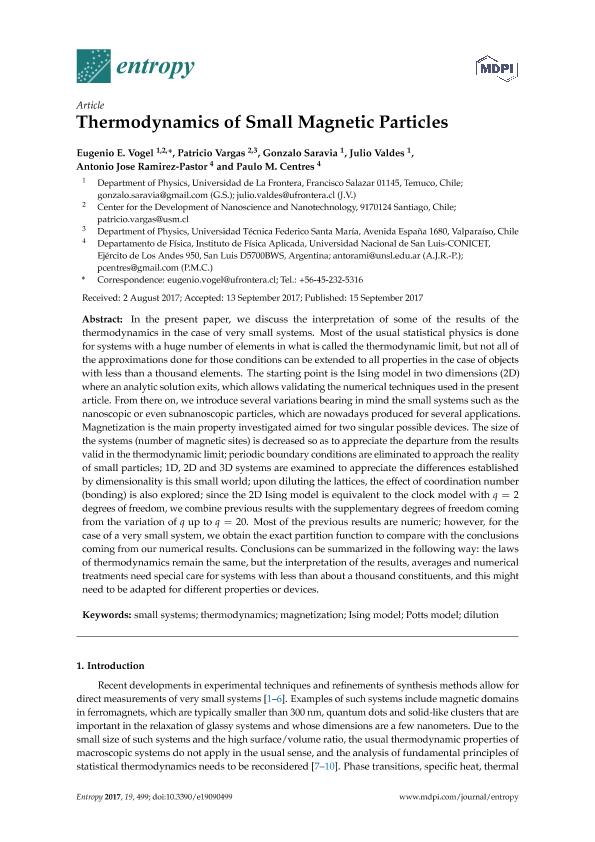Mostrar el registro sencillo del ítem
dc.contributor.author
Vogel, Eugenio
dc.contributor.author
Vargas, Patricio
dc.contributor.author
Saravia, Gonzalo
dc.contributor.author
Valdes, Julio
dc.contributor.author
Ramirez Pastor, Antonio Jose

dc.contributor.author
Centres, Paulo Marcelo

dc.date.available
2018-11-07T15:30:49Z
dc.date.issued
2017-09-15
dc.identifier.citation
Vogel, Eugenio; Vargas, Patricio; Saravia, Gonzalo; Valdes, Julio; Ramirez Pastor, Antonio Jose; et al.; Thermodynamics of Small Magnetic Particles; Molecular Diversity Preservation International; Entropy; 19; 9; 15-9-2017; 1-20
dc.identifier.issn
1099-4300
dc.identifier.uri
http://hdl.handle.net/11336/63862
dc.description.abstract
In the present paper, we discuss the interpretation of some of the results of the thermodynamics in the case of very small systems. Most of the usual statistical physics is done for systems with a huge number of elements in what is called the thermodynamic limit, but not all of the approximations done for those conditions can be extended to all properties in the case of objects with less than a thousand elements. The starting point is the Ising model in two dimensions (2D) where an analytic solution exits, which allows validating the numerical techniques used in the present article. From there on, we introduce several variations bearing in mind the small systems such as the nanoscopic or even subnanoscopic particles, which are nowadays produced for several applications. Magnetization is the main property investigated aimed for two singular possible devices. The size of the systems (number of magnetic sites) is decreased so as to appreciate the departure from the results valid in the thermodynamic limit; periodic boundary conditions are eliminated to approach the reality of small particles; 1D, 2D and 3D systems are examined to appreciate the differences established by dimensionality is this small world; upon diluting the lattices, the effect of coordination number (bonding) is also explored; since the 2D Ising model is equivalent to the clock model with q=2 degrees of freedom, we combine previous results with the supplementary degrees of freedom coming from the variation of q up to q=20. Most of the previous results are numeric; however, for the case of a very small system, we obtain the exact partition function to compare with the conclusions coming from our numerical results. Conclusions can be summarized in the following way: the laws of thermodynamics remain the same, but the interpretation of the results, averages and numerical treatments need special care for systems with less than about a thousand constituents, and this might need to be adapted for different properties or devices.
dc.format
application/pdf
dc.language.iso
eng
dc.publisher
Molecular Diversity Preservation International

dc.rights
info:eu-repo/semantics/openAccess
dc.rights.uri
https://creativecommons.org/licenses/by-nc-sa/2.5/ar/
dc.subject
Small Systems
dc.subject
Thermodynamics
dc.subject
Magnetization
dc.subject
Dilution
dc.subject.classification
Física de los Materiales Condensados

dc.subject.classification
Ciencias Físicas

dc.subject.classification
CIENCIAS NATURALES Y EXACTAS

dc.title
Thermodynamics of Small Magnetic Particles
dc.type
info:eu-repo/semantics/article
dc.type
info:ar-repo/semantics/artículo
dc.type
info:eu-repo/semantics/publishedVersion
dc.date.updated
2018-10-23T17:31:15Z
dc.journal.volume
19
dc.journal.number
9
dc.journal.pagination
1-20
dc.journal.pais
Suiza

dc.journal.ciudad
Basel
dc.description.fil
Fil: Vogel, Eugenio. Universidad de La Frontera; Chile. Center for the Development of Nanoscience and Nanotechnology; Chile
dc.description.fil
Fil: Vargas, Patricio. Center for the Development of Nanoscience and Nanotechnology; Chile. Universidad Técnica Federico Santa María; Chile
dc.description.fil
Fil: Saravia, Gonzalo. Universidad de La Frontera; Chile
dc.description.fil
Fil: Valdes, Julio. Universidad de La Frontera; Chile
dc.description.fil
Fil: Ramirez Pastor, Antonio Jose. Consejo Nacional de Investigaciones Científicas y Técnicas. Centro Científico Tecnológico Conicet - San Luis. Instituto de Física Aplicada "Dr. Jorge Andrés Zgrablich". Universidad Nacional de San Luis. Facultad de Ciencias Físico Matemáticas y Naturales. Instituto de Física Aplicada "Dr. Jorge Andrés Zgrablich"; Argentina
dc.description.fil
Fil: Centres, Paulo Marcelo. Consejo Nacional de Investigaciones Científicas y Técnicas. Centro Científico Tecnológico Conicet - San Luis. Instituto de Física Aplicada "Dr. Jorge Andrés Zgrablich". Universidad Nacional de San Luis. Facultad de Ciencias Físico Matemáticas y Naturales. Instituto de Física Aplicada "Dr. Jorge Andrés Zgrablich"; Argentina
dc.journal.title
Entropy

dc.relation.alternativeid
info:eu-repo/semantics/altIdentifier/doi/https://dx.doi.org/10.3390/e19090499
dc.relation.alternativeid
info:eu-repo/semantics/altIdentifier/url/https://www.mdpi.com/1099-4300/19/9/499
Archivos asociados
